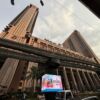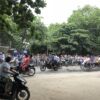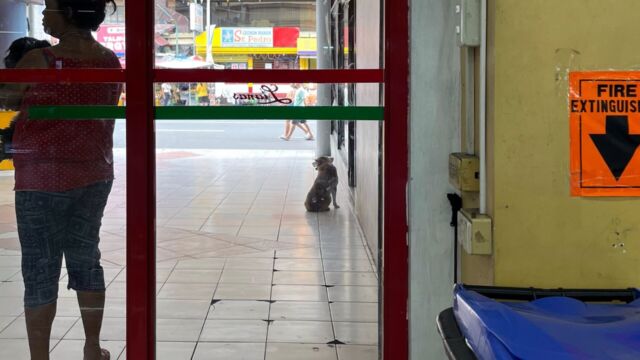Lantana Began a Life In-Between
Cubao Cathedral. Photo: March Abuyuan-Llanes
Cubao | 3,539 words
I.
When I was eight years old, my family began renting and living in a large ancestral house in Cubao, the commercial district and transportation center of Quezon City. “Large” and “ancestral” hardly capture the house’s scale and architecture, however. It was an art deco mansion of three floors and countless rooms, with two smaller buildings flanking it, and a driveway and garden that sprawled in front, all of it surrounded by balete trees, fruit trees, and a wall that kept it separate from the rest of the city’s chaos. Situated atop a hill and on a busy corner along Lantana Street where two other roads met, the house stood right across from the Cubao Cathedral, amidst hundreds of daily tricycles and jeepneys full of commuters on their way to the church or to nearby markets and bus terminals. The art deco style, the curvilinear window grilles, and tanguile floors dated the house to the postwar period, making it among the oldest homes in Cubao, or about as old as the cathedral.
I still remember when we first moved in. Besides being a residence, the house was also the location of a small alternative school that my twin sibling and I had already been enrolled in for two years. I remember the months and weeks leading up to it: telling my Grade 2 classmates that CJ and his mom were moving to America, and that we’d be taking over the business and living there instead. We’d be painting over everything that was blue with a white that our stepdad liked more, and my mom would help run the school.
Our first night there, we all slept in a single room that would eventually become my older sister’s. I remember the chemical scent of fresh paint, and for the first time of what would be thousands, the cathedral’s bells waking me and my family up too early in the morning. I remember my eight-year-old amazement. We used to live in a small cramped townhouse further north in Quezon City, and now we lived in a place that felt like a castle in comparison, one that was both my school and home at once. For the rest of my childhood and adolescence, my whole world would be in Cubao. It was where I grew up and studied and where my family made a living out of our school and our bar located just minutes away in a hub of local shops and indie businesses called Cubao Expo.
Eleven years on from that first night, my stepdad called me downstairs to talk about something. He sat me down and told me that the house was being sold, behind our backs no less. He found out through someone who confided that the landlords were keeping the news from us in order to continue collecting rent until the very last minute. After living most of my life in Lantana, which to us came to refer to the house rather than the street, we suddenly had to move out as soon as possible.
Beneath the grief and shock, we knew the fate that would befall Lantana because we’d seen it happen to so many other places, from the Santa Cruz Building in Escolta in downtown Manila just two years prior to my own family’s ancestral house in Tuguegarao before I was born. Hardly anyone would buy a lot this expensive for the house itself. It was beautiful and historical, but it was too big and too old, a burden for any rich buyer who’d care far more about profitability than the history or lives spent in an ancestral house they’d have to maintain. Once it was bought, it would only be a matter of waiting: the house would be demolished and built over with a Jollibee or 7-Eleven or Mercury Drug or some other ubiquitous commercial establishment—to be lost like everything everywhere else in Metro Manila.
II. Barangay Immaculate Concepcion
Set upon the house’s red wall from which the balcony extended was a large letter “T” on a white stone escutcheon, like an ornate coat of arms. Before my family and the previous tenants, Lantana was the home of Senator Arturo “Turing” Tolentino, the famed politician and running mate of dictator Ferdinand Marcos Sr. in the 1986 presidential snap elections whose fraudulent results would catalyze the People Power Revolution that ousted Marcos after 21 years and installed Cory Aquino as president. With Manila still being rebuilt following its destruction during World War II, the Tolentinos moved from España Boulevard to their new house in Quezon City, which had just recently been established to replace Manila as the country’s capital. From then until Senator Tolentino’s death, Lantana was where he met dignitaries, the home he returned to after his failed two-day siege of the Manila Hotel to restore Marcos Sr. back in power, where he ate breakfast with his family every day, and where he would pass away in 2004.
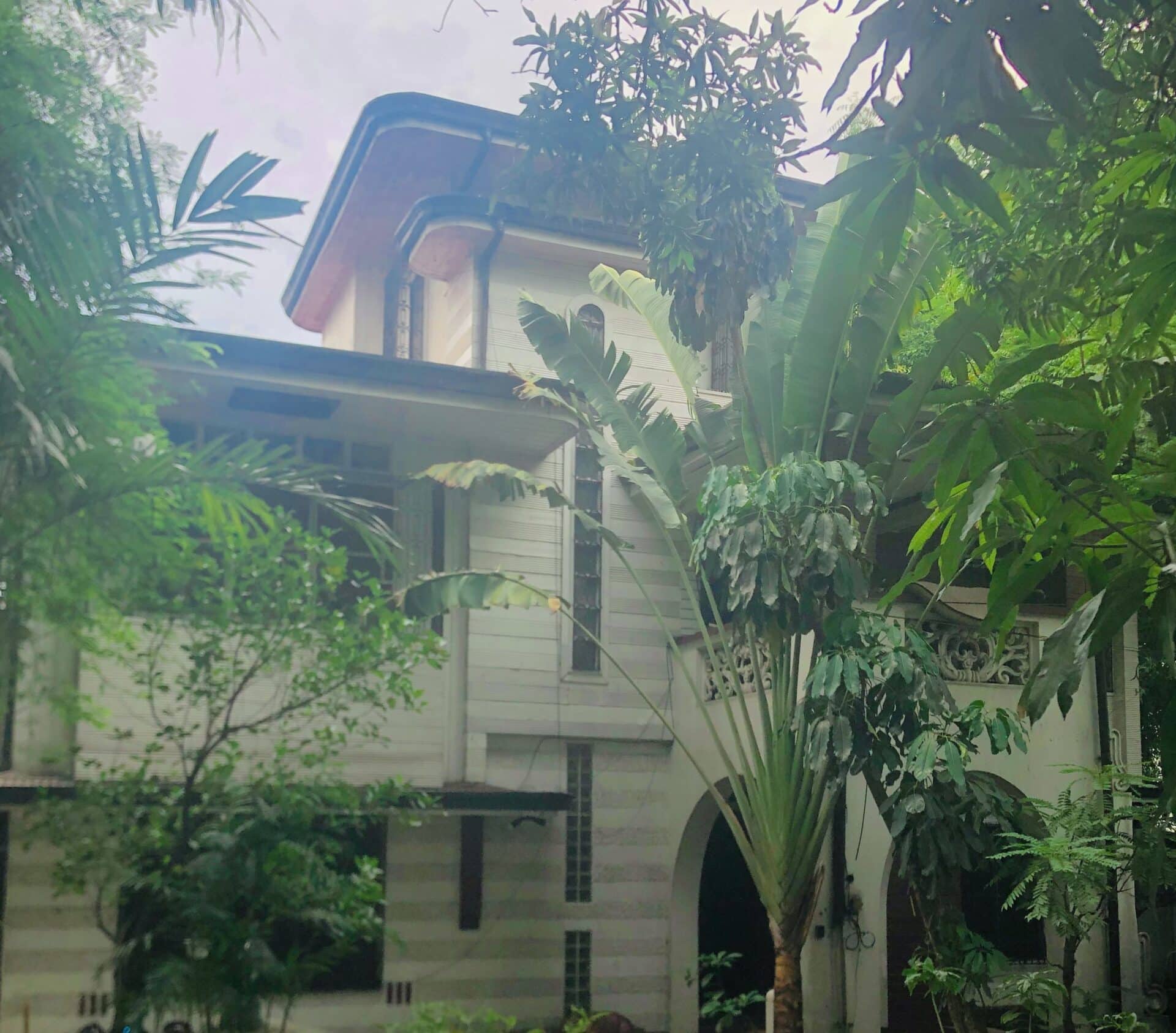
In the aftermath of their patriarch’s death, Tolentino’s immediate family emptied the house and began renting it to other families who each made their own mark on Lantana over the years. Chandeliers were replaced with simpler light fixtures; new walls were built; a storage shed was constructed; the pool in the garden was filled with dirt; a bathroom was added, and so on. Eventually, a bahay kubo (a nipa hut on stilts) was also built in the garden where there used to be outdoor showers. By the time my own family moved in and took over the previous tenants’ small schooling business in 2012, what Lantana had been to the Tolentinos—their ancestral home of ancestral wealth—was well in the past, alongside its unwritten role in the margins of national history. Though still the largest city in the Metro, Quezon City had changed just as much, having lost its status as the capital back to Manila decades ago, and with a skyline of buildings no longer as new and shiny as those of the cities in the south of the metropolis.
Most of the ground floor of Lantana had been repurposed into space for the school, apart from the kitchen, the helpers’ bedrooms, and a room that would become my mother’s office. Where there were once zebra skin rugs in the sala, a narra table in the dining room, and dresses in the sewing room now sat school supplies, books, and whiteboards in repurposed classrooms. It was on the second floor that my family made our home, living above the school. From grade-school onto high-school, class for my twin sibling and I would just be a walk down the stairs.
Although Lantana was quite large for a house, it was still much smaller than an actual school building, accommodating less than forty students and a handful of teachers across preschool and grades one to ten at a time. Nonetheless, it was the perfect location. We were a progressive, non-traditional school and, in turn, always a tight-knit community. Everyone knew each other, including students, faculty, and even parents, and a classroom would number ten at most, grades mixed in with other grades.
Because of this, learning was constantly close and personal. Classes were never just one-sided lectures in front of a chalkboard, and neither was our work limited to worksheets and quizzes. Instead, a class at our school looked more like a roundtable of kids figuring out fractions and water colors together, or teenagers discussing the People Power Revolution and Ang Ibong Adarna, while a grown-up guided us. We were all given the space to speak and express ourselves even if we were young, our curiosity and experiences always valued more than our grades. Often, we’d have class outdoors, either in the bahay kubo in the garden or under the sampalok tree beside it. The sun and wind would pass through the leaves as Teacher Louie or Teacher Zeena would weave from topic to topic, and we’d laugh as much as we’d listen.
Once the church bells rang to signal breaktime, Lantana’s garden and driveway transformed into an outdoor court and a playground and everything between for us. On some afternoons, the two Marian grottos at opposite ends of the lot became bases for agawan base, or tag; on others, certain places became the best hiding spots for hide-and-seek: the dank nook behind one of the mango trees, or the narrow in-betweens of the red pilasters at the far end of the house. All kinds of animals enjoyed Lantana’s open space, too: we had a family of labradors who’d sit in during classes, a strange, hairless askal who lived on the mansion’s roof, a bearded dragon the preschoolers called Kuya Burrito, countless chickens and ducks, koi fish in the pond for good luck, and at one point, even a massive, elephantine pig named Steak who slept all day beneath the bahay kubo. When we got older, and played less and gossiped more, the lunch tables beneath the balcony or the shade of the balete at the back became our favorite spots instead.
If we wanted more drinks or snacks, me and my classmates would sometimes exit Lantana’s grounds to buy some at the shops nearby. We would often go to the sari-sari store across the house for chips and soft drinks, or to the old bakery by the cathedral which churchgoers also frequented for pandesal and ensaymada. Just as often, we’d walk to the 7-Eleven or Ministop along E. Rodriguez Sr. Avenue, where cars, jeeps, and buses would be rushing to Manila in the west or Cubao’s malls in the east. The area around Lantana was on a threshold between residential and commercial, with its few remaining houses slowly being replaced by more and more conglomerate-owned businesses. It was easy to feel as if we were the only house there, eternal and untouched on our corner like the church across from us. The closest we had to neighbors were the tricycle drivers who parked outside Lantana’s walls as if it were some kind of landmark, and the barangay workers with whom we’d occasionally share fruits from our mango trees.
Besides the weekends, it was really only after classes that the house would return to simply being a house, save for all the empty school desks and whiteboards. By late afternoon, all the teachers and other kids would have gone home, and it would only be me and my twin sibling left downstairs before the sun began to set. Back upstairs, the door to my mom’s room would be left open, where most of the time she’d be working by the lamplight: writing and editing for a publication, or managing plans for the school.
Despite how busy she was, she somehow always made the time to let us in and tell her stories about our day. My stepdad would sometimes be there, but often he’d be at Fred’s Revolución, our bar in Cubao Expo, leading the crew in the kitchen or just drinking with friends, our dog Chaplin by his side as regulars passed by and petted her. On special occasions like after a long meeting or a holiday, Lantana sometimes became the venue for celebration. Tables of food and alcohol would be arranged in rooms where, just a few hours ago, students were having class, and the whole Fred’s crew would come to drink and laugh the entire night, the ground floor alive and noisy like a pub.
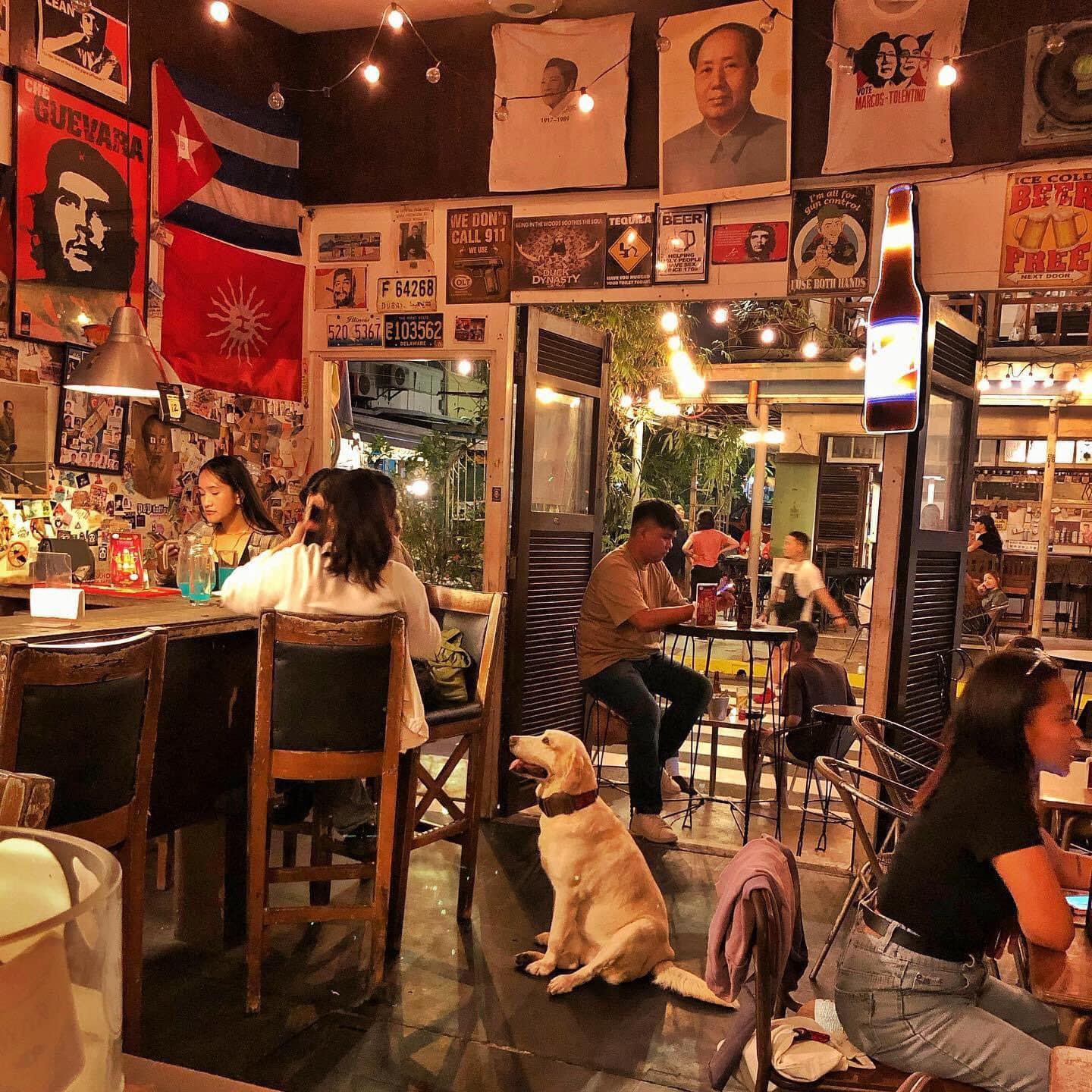
Lantana was the first home we really lived in together after my stepdad returned from working in Dubai, where we first made a stable living, and where, in a way, we first became a family. Our school shaped me, indelibly, in terms of who I am and what I believe in. I learned to love learning there. It was where I read and wrote my first poems, and where I first knew, from my teachers and the stories of struggle they taught, that poetry, like bread, is for everyone. It was a community where I could be myself, wholly and unapologetically—an upbringing which I think all kids, and not just me and my other queer, neurodivergent, or disabled classmates, should have as well. What Lantana also meant to them, to their parents, or to every other person who visited our house, I cannot tell you. I just wish you could’ve been there.
III. Barangay Socorro
One early morning in late November in 2018, my mother suffered a sudden and severe asthma attack. My older sister burst into my room to wake me up, rushing me into our mother’s bedroom where the rest of my family was. Our mom was sitting on her side of the bed, gasping for air as her lungs closed and her nebulizer failed to keep her airways open. Just three kilometers away, the ambulance my stepdad had called was stuck in traffic, so my siblings and I stayed by our mom, waiting. Before I knew it, our mother was limp on a stretcher as the first church bells of the morning rang, being brought down the stairs in front of teachers about to suspend class and school children, and into a barangay ambulance that had come first but lacked any proper medical equipment. At the hospital, my mother would fall into a coma, until doctors declared her brain-dead a day later, only five days before my twin sister and I turned fifteen.
Instead of a traditionally solemn funeral, we knew exactly what our mom would’ve wanted: a celebration of life full of eating, drinking, dancing, and music. So we held one for her, naturally, at Fred’s Revolución, on the day that also happened to be me and my twin sister’s birthday. Everyone who could come did, all the people my mother had ever known. The crowd spilled out from our pub, where my mom’s urn stood on the bar alongside piles of food and alcohol, and onto that side of Cubao Expo. The evening became a block party in her name, complete with a DJ who played Prince and The Cure all night. Teenage me, suddenly fifteen and motherless, dancing with countless people who were sweaty and drunk and telling me everything my mother meant to them. Writer, editor, educator, beer-lover, friend, sister, mother, fierce, generous, and amazing woman—despite everything—and so much more.
Amidst my grief, I began to leave the house more, hurling myself into the local ballroom and voguing scene. In those early days, our main dance studio was in Araneta “City”, a dense, town-sized complex of shopping centers, offices, condominiums, and other high-rise buildings all built and owned by the eponymous Spanish-Filipino dynasty. That jungle of malls and edifices is one of the first things people think of when someone says “Cubao”: either that, or all the train, jeepney, and bus routes that meet and spread out from there, like a beating urban heart.
That dance studio, nestled between fast food chains and apartments under construction, was where I would go nearly nightly to train with my ballroom house, voguing and catwalking and dipping and bending our bodies until our muscles were sore. It was all I did and wanted to do during that time: dancing and dancing. My first performance on a stage would be in Araneta City’s New Frontier Theater, while my first ball would be in that same dance studio. Runway music pounding and queens sashaying, that place became something of a second home to me.
When I wasn’t voguing, I was going out with my friends after class like a typical high-schooler. We would walk around the malls in Araneta, idling in the air-conditioning because we’d never have any money and often just end up in Cubao Expo. Even back then, I found it miraculous how that small u-shaped enclave of antique shops, record stores, and other indie businesses stood at the edge of such a commercialized and corporate labyrinth. Right in the middle of Expo, my family’s pub itself was a popular drinking spot for queer people, artists, and activists. Its walls jostling with socialist art and posters probably has something to do with its clientele, but at that age, we were there for the free food, which was all on my stepdad. Today, the table I always choose at Fred’s is still the same one on the second floor, beside a window and across a portrait of my mother by the bar.
A lot of the time, however, I would simply go out by myself. Thrifting clothes alone was my favorite thing to do then, which is another “Cubao thing.” The area teems with thrift shops, but the one I would go to the most was an old, dingy building right up against the LRT station in Anonas, with floors and floors of clothes on neon green hangers and an odd smell in the air. My wardrobe came to be filled with strangers’ old blouses and pants, on top of jackets and jewelry I’d taken from my mom’s own closet. Maybe it was because of her death or my being young and queer, or both, but I was fixated then not on who I was but on creating myself as quickly as possible through clothes and through dance. What I wore and what my body could do. All those hours in front of mirrors, and all those hours down Cubao’s unwalkable sidewalks. I believed I was becoming who I was meant to be.
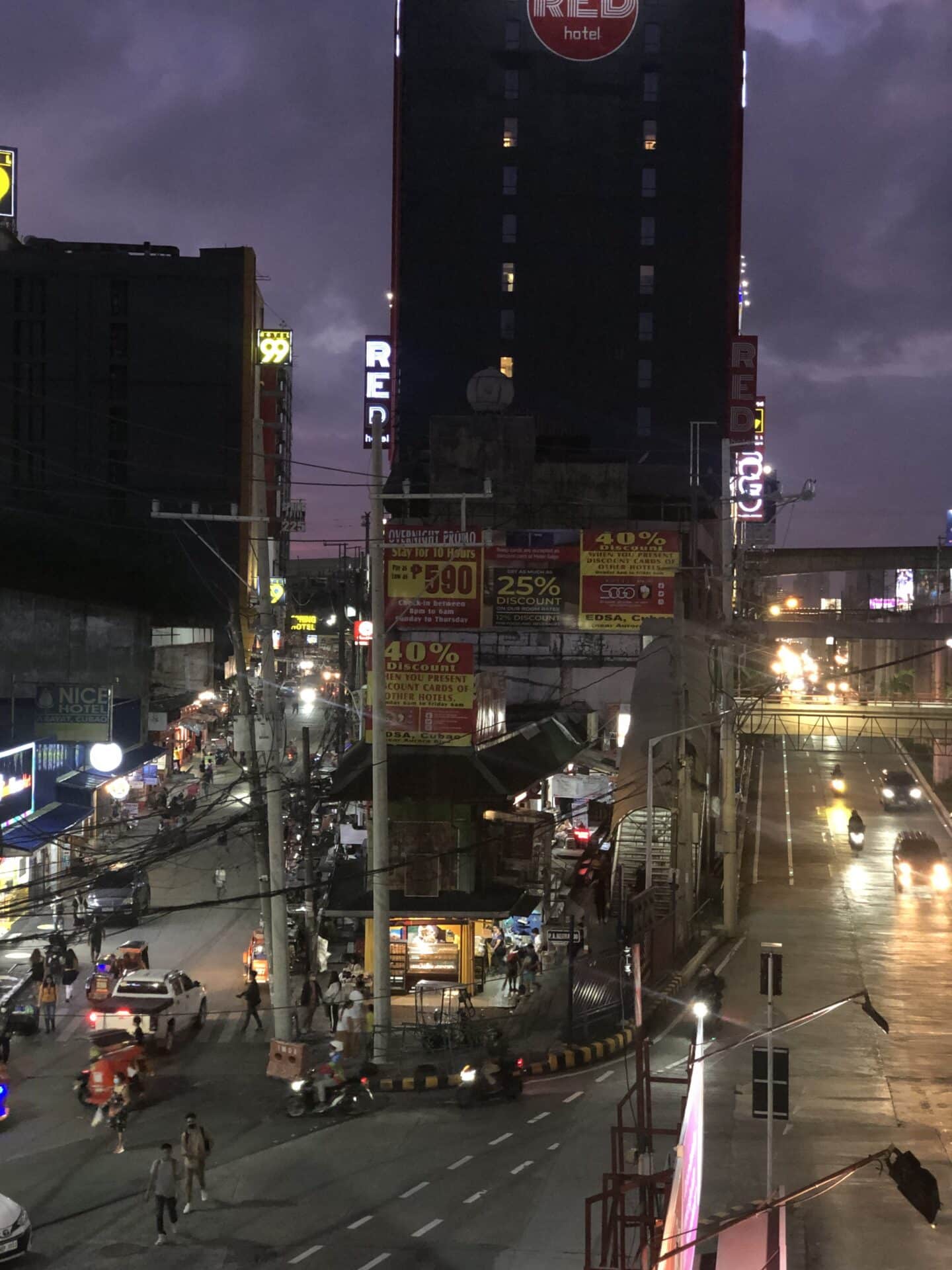
As I was forced to grow up, Cubao also changed with me. It was no longer just our art deco house across the cathedral, but all of its buildings and alleyways that I found myself in, and all of those I would never enter.
Then, the whole world went into lockdown, and life for my family became even harder. The school would be empty for two years, and Fred’s would be closed for almost as long. I was back in Lantana, but this time because I had no choice. I stopped dancing and threw myself into writing instead. Outside, the churchgoers disappeared, and even the cathedral’s bells went silent.
IV. Barangay Pinagkaisahan
Since my college returned to onsite classes, I’ve been commuting one to two hours every day, each way, to my campus in the south of Manila, despite it only being eight kilometers away. I take a combination of all three train lines, tricycles, walking, and sometimes jeeps. The commute in Metro Manila is just one of the many daily absurdities of living in a capital like this, whose workers and students must decode an unstandardized system of routes and endure hours in transit, sleepless, sweating, and cramped-up like livestock in buses, jeepneys, UVs, and trains, in one of the world’s most densely populated metropolitan areas with some of the world’s worst traffic.
I think a lot about liminality during my commute: the transient state between two things or two places, of being neither here yet nor there. Cubao, I feel, is marked by liminality, with all its stations, motels, markets, and bars. It’s where people go not to stay but to find themselves elsewhere eventually. Living here, I see much of my life as liminal, too. Growing up in our house that was also my school; no longer being a teenager though still not quite an adult; even my gender; and, of course, that wayward raft inside me that is grief, always drifting between the constancy of life and the inevitability of death. What I do that isn’t work or rest, I do during rush hour, when I read heading into campus in the LRT and write on the way back. It’s hard not to feel that I exist perpetually in transit, with the end always somewhere on the horizon.
Maybe it was uncharacteristic of me to think that Lantana would remain, if not forever, then for at least a little longer. In reality, that house was always falling apart, and living there meant a continuous struggle to maintain it through termites and decay. The moment we took out our last piece of furniture, a crack suddenly formed in the pond, draining the water and suffocating all the koi fish. Memories, whether just a family’s or an entire community’s, are not enough to keep a building from rotting away, from being sold, or from being demolished.
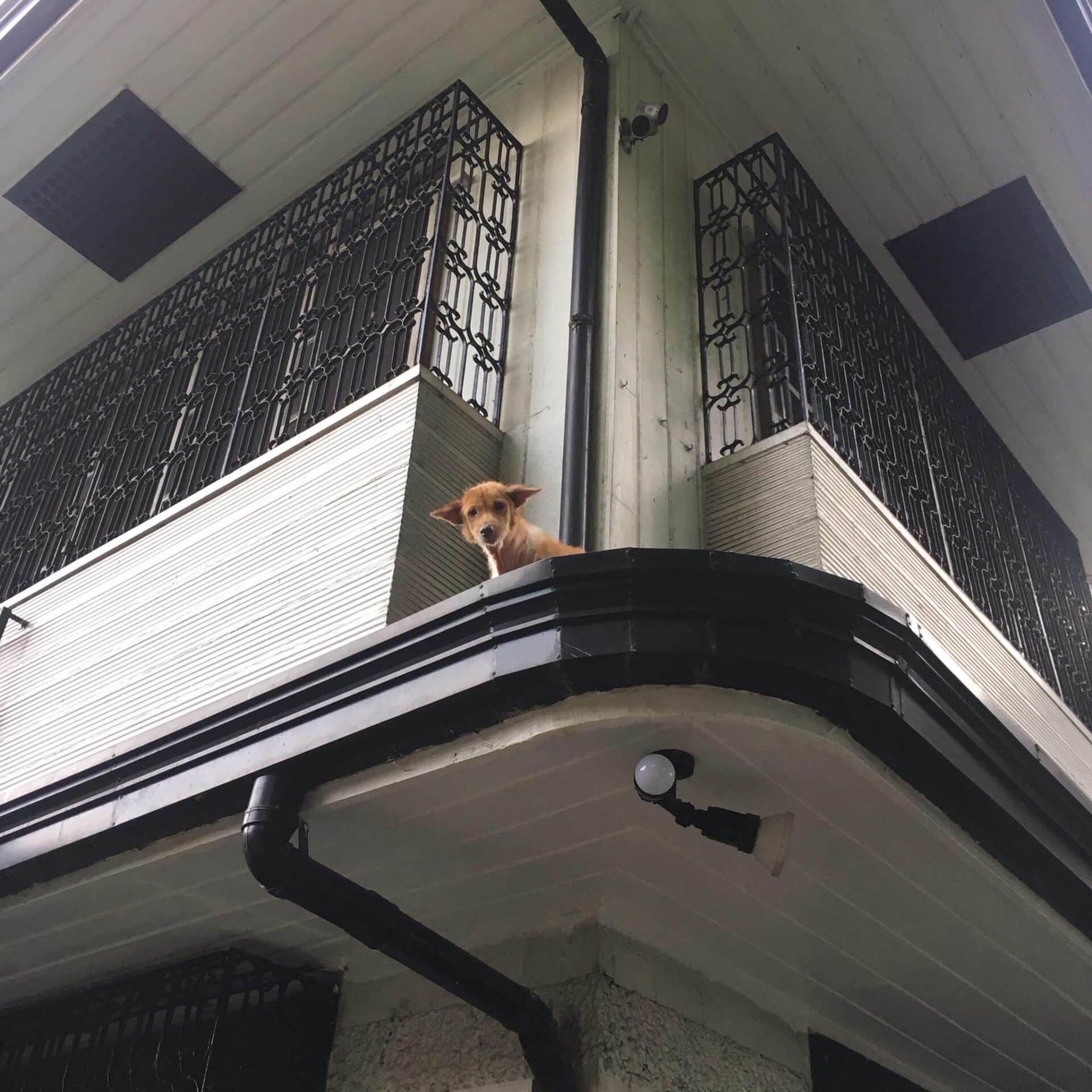
I am writing this in our new house, only five months after we moved in and just a few streets down from Lantana. Our school has relocated with us, and my daily commute remains identical. On the way back from my college, I still watch the train window in anticipation of those huge, neon signs of Araneta City and Arayat to signify that I’m finally in Cubao, as liminal as it is home. On the final tricycle to our new address, I always pass by Lantana, and, sometimes, I ask the driver to drop me off there instead.
I look at the house from the outside, now completely devoid of light, people, and furniture, and see the same darkness I see underneath the footbridges in EDSA at night. I wonder when they’ll finally demolish the house, and build that Jollibee or 7/11 or Mercury Drug over it. Then, I wonder when that, too, will eventually rot away, and what hopefully more beautiful thing we’ll build in its place.
© March Abuyuan-Llanes
Commissioning editor: Glenn Diaz

